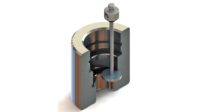Not All that is Green is Good
There are methods to hide bad product under green numbers.

There is a long-standing practice in the computer aided inspection industry that includes CMMs to report in-tolerance values in green and out-of-tolerance values in red. The red numbers have come to trigger, if not outright alarm, by their mere presence in a report, while green reports are glossed over and forgotten. Just as there are ways to revise a CMM routine or evaluation to change the red reports to green, there are methods to hide bad product under green numbers.
Why Do We Believe Green is Good?
All tolerances begin with the engineering department, so we’re inclined to trust that these number crunching technical professionals picked correct tolerances, and even when they don’t downstream departments like manufacturing and quality generally don’t have enough information to challenge the tolerance. Thus, we find serenity in accepting the engineer’s tolerance as the delineator between good and bad product.
At the time of feature inspection, the program has been written, edited, and run on at least one sample part. It is likely that this prove-out process as had several rounds to generate values that are acceptable to the customer (customer may be internal or external). In this process the programmer may find that collecting data from here rather than there is more likely to result in the ultimate goal of green (in-tolerance) results.
Knowing that a feature is in-tolerance is important to the organization. Not only does it indicate that the product being inspected is acceptable to sell, but it also indicates that the process(es) used to make the part is under control. For those that track CpK values this would mean a value of 1 or better will be assigned to the process. As trouble shooting a manufacturing process and retooling can be a major strain on time and budget, multiple levels of management want to see the green report.
A recent customer experience demonstrates this case. The customer knew that the proximity of a welded joint tended to make a nominally round feature “egg shaped.” The customer programmed a circle rather than a cylinder feature. The cylinder feature in this case was approximately 25mm long, so it would have been easy to have collected cylinder data.
Report of the Feature O.D. as a Circle
CIR_30.050_OD
- Actual
30.089 - Nominal
30.050 - Low Tol
-0.050 - High Tol
0.050 - Deviation
0.039
The resulting circle feature reported green, and the programmer was pleased with himself.
Why Accepting Carte-Blanc Green is Good may be Misguided
In a typical CMM report, like the one illustrated above, the feature name may indicate what geometry is being reported—in this case a circle feature. In other cases, the name may be customized such that the geometry (CIR) is completely replaced and the reader of the inspection report is oblivious to the basic nature of the geometry being reported. This is important because the engineer’s diameter specification does not simply apply to the circle on the part the inspector chooses it to. The specification applied to the entire length, width, and depth of the feature (see ASME Y14.5 fundamental rules). In changing the measurement from a circle, where 10 points were used, a cylinder of 20 points was felt to be acceptable because it provided the data of the initial circle fitting at each end of the cylinder. The results were changed as follows:
Report of the Feature O.D. as a Cylinder
CYL_30.050_OD
- Actual
30.104 - Nominal
30.050 - Low Tol
-0.050 - High Tol
0.050 - Deviation
0.054
Now that the features are reporting red, the programmer in uncomfortable with the results of the program.
The descriptive name of the feature reveals a reason why this report of the same cylindrical surface on the part now reports very differently than it did before. Depending upon the industry segment you are working in you may recognize, as the customer did, that 0.004mm is a very small amount to be out-of-tolerance. Rather than scrapping or reworking the part, or worse making a significant process correction to eliminate this, the customer felt that their customer would likely approve a deviation and buy off the parts even though this is technically out-of-tolerance.
However, upon further inspection of the program and results it was understood that the fitting algorithm of the feature, as programmed, was the system default of Least Squares. The Least Squares fitting algorithm is a mainstay of CMM metrology. It is very robust and repeatable but is not always in conformance with engineering standards. In the ASME Y14.5 standard the measurement of an external diameter is defined as the smallest counter geometry that may be circumscribed about the feature only contacting the high points of the O.D. This would be describing a minimum circumscribed fitting algorithm. Most CMM software will offer some variety of fitting algorithms. This is where alignment between the quality department and the engineering department becomes critical if we are to ensure that the design intent, failure modes, and all predictive analysis—like FEA and CFD—are valid for the product as shipped. At this time, the fitting algorithm of minimum circumscribed was added to the program. The cylinder feature was rerun for a new evaluation and the results were as follows:
CYL_30.050 O.D.
- Actual
30.114 - Nominal
30.050 - Low Tol
-0.050 - High Tol
0.050 - Deviation
0.064
The increase in deviation from 0.054 to 0.064 alarms the programmer.
While it can be uncomfortable to deliver bad news, it is critical that inspections provide a thorough and accurate evaluation of the requirements. This part was brought to inspection because there was a problem with the build. Providing anything less than a thorough and accurate evaluation, in conformance with all details of the engineering specification would have led to a decision of sending this part back to the assembly line (with or without a deviation). The accurate evaluation revealed the full extent of non-conformance and that it was too much to approve, even under a deviation.
It is important to note that the change in the fitting algorithm is not stated in the CMM report. Text statements can be added to reports to clarify for the reader the conditions of feature measurement. Some examples for the results generated in this case are shown below.
********************
MINIMUM CIRCUMSCRIBED FITTING
CYLINDER OF 60 DATAPOINTS
NO FILTERING
CYL_30.050_OD
- Actual
30.114 - Nominal
30.050 - Low Tol
-0.050 - High Tol
0.050 - Deviation
0.064
********************
Looking for a reprint of this article?
From high-res PDFs to custom plaques, order your copy today!





